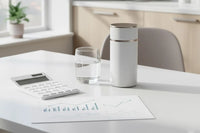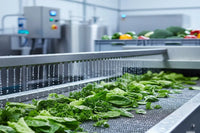What is HOCl and How Is It Generated On-Site?
Hypochlorous acid (HOCl) is a powerful yet gentle disinfectant made from just water, salt, and electricity. Through a process called electrolysis, a hypochlorous acid generator splits a simple brine (saltwater) solution with an electric current to produce HOCl on demand.
The formula: salt (NaCl) + water (H₂O) + electricity → HOCl, plus a mild sodium hydroxide byproduct in some systems.
This means no added chemicals to ship or handle – just plug in the generator, add salt and water, and create a fresh supply of non-toxic sanitizer on-site.
HOCl isn’t new or mysterious – it’s the same substance your immune cells produce to destroy pathogens. In solution, HOCl provides the microbicidal power of chlorine (it’s the active ingredient in chlorine bleach) but in a far safer form. It’s been shown to be up to 80–100 times more effective at killing microbes than bleach while remaining harmless to humans and foods. At the right pH, over 95% of an HOCl solution is the active, germ-killing molecule, making it a potent, fast-acting sanitizer that eliminates bacteria, viruses, and fungi in seconds — yet breaks down into simple saline.
Because HOCl starts as just saltwater, it is intrinsically safe and environmentally friendly. There are no harsh chemical additives – just a naturally occurring acid that leaves no toxic residues. This unique profile lets HOCl achieve the same or better disinfection results as traditional sanitizers without the drawbacks.
HOCl vs. Legacy Sanitizers: Bleach, Chlorine Dioxide, Ozone, and Quats
For decades, food processing facilities have relied on harsh legacy sanitizers like chlorine bleach, quaternary ammonium compounds (quats), peracetic acid, chlorine dioxide, and ozone to meet hygiene standards. While effective against microbes, these chemicals bring a host of problems in food environments — corrosion of stainless steel, degradation of seals, residues that reduce product shelf life, and strong odors. The real threat isn’t always the bacteria — sometimes it’s the sanitizer.
Unlike traditional chemicals, HOCl works without corroding equipment or risking food quality. It is dramatically more efficient at killing pathogens while remaining gentle on food and surfaces.
Bleach (Chlorine)
Widely used but highly corrosive to equipment and surfaces. Chlorine bleach requires full PPE and leaves residues that must be thoroughly rinsed off. These residues can cause off-flavors and shorten shelf life. In contrast, HOCl is non-corrosive and leaves no detectable residue, eliminating the rinse step. It kills pathogens up to 99.999% in seconds without the caustic side effects.
Chlorine Dioxide
Effective but hazardous in food plants. It must be mixed on-site, is explosive at high concentrations, and unsafe for occupied rooms. Workers often need full protective suits and lengthy rinse cycles. HOCl, by comparison, is safe, made on demand, and can be fogged or sprayed even with staff present.
Ozone
A strong oxidizer used in seafood and produce processing, but toxic to people and damaging to equipment. HOCl offers a similar microbial kill while being safe for workers and can even be used continuously in occupied spaces. Unlike ozone, HOCl leaves a mild residual that continues sanitizing briefly without harm.
Quaternary Ammonium Compounds (Quats)
Common for floors and walls, but problematic on food contact surfaces. Quats can leave residues that contaminate food and are not allowed in organic production. HOCl, on the other hand, is food-contact safe, requires no rinse, and breaks down into simple saline.
Peracetic Acid (PAA)
PAA is potent but extremely harsh — it can burn eyes, skin, and lungs. HOCl achieves the same microbial kill without burns, fumes, or corrosion.
In short: traditional sanitizers force a trade-off between effectiveness and safety. HOCl eliminates that trade-off, providing superior pathogen control without hazards or residues.
100% Safe and Food-Contact Approved – No PPE or Rinse Required
One of HOCl’s greatest advantages is its safety for both humans and foods. No special protective equipment is needed when handling or applying it. Workers can spray, wipe, or fog HOCl in occupied areas with zero irritation to skin, eyes, or lungs. It’s even been studied for use as a medical mist for throat and lung health.
HOCl can be applied directly as a produce wash without rinsing, leaving no residues or off-tastes. It’s approved by regulatory agencies including the EPA, FDA, USDA, and NSF for use in food processing. It’s also certified as a no-rinse sanitizer for food surfaces and approved for use in organic food production.
With a non-toxic, no-residue sanitizer, compliance becomes simpler. HOCl helps operations meet sanitation standards and maintain food safety without chemical adulterants or rinse requirements.
Real-World Results: Cutting Costs, Water, and Risk while Extending Shelf Life
Companies that have switched to HOCl report major benefits: lower costs, greater efficiency, safer work environments, and longer shelf life for their products.
Lower Costs and Chemical Savings
On-site HOCl generators use only salt and water, eliminating expensive chemical purchases and shipping costs. Facilities save on procurement, storage, and equipment maintenance since HOCl doesn’t corrode or damage surfaces like bleach or peroxide can.
Water and Labor Efficiency
Because HOCl requires no rinse, facilities reduce water use and cleaning time dramatically. Some operations have reported cutting water use by 50% and sanitation labor hours by half after switching to HOCl — saving thousands of dollars monthly while streamlining workflows.
Enhanced Worker Safety
Traditional sanitizers pose risks of burns, toxic fumes, or mis-dilution accidents. HOCl removes these hazards, improving worker morale and reducing liability. OSHA incidents related to chemical exposure can drop significantly.
Longer Shelf Life and Product Quality
HOCl eliminates spoilage microbes without altering taste, texture, or pH, extending the shelf life of produce, seafood, and proteins. Foods stay fresher longer, with no chemical aftertaste or residue.
Sustainability and Environmental Benefits
HOCl breaks down into saltwater, leaving zero environmental footprint. It reduces chemical transport emissions and wastewater impact, aligning with sustainability initiatives and green certifications.
The New Standard: HOCl as the Inevitable Solution
HOCl checks every box — microbial efficacy, compliance, savings, safety, product quality, and sustainability. The era of harsh chemicals is ending, and processors are turning to HOCl as the safer, smarter choice.
Modern generator systems can now produce HOCl directly in your facility — whether you need a few liters for produce washing or hundreds of gallons for full-scale sanitation. No more ordering drums of chemicals or worrying about shelf life. HOCl is fresh, powerful, and always ready when you need it.
Bottom line: HOCl isn’t just an alternative; it’s the future of food processing sanitation. It delivers better results with fewer downsides, aligning with both safety regulations and sustainability goals. Embrace the HOCl revolution and experience a cleaner, safer, and more efficient way to sanitize your facility.





